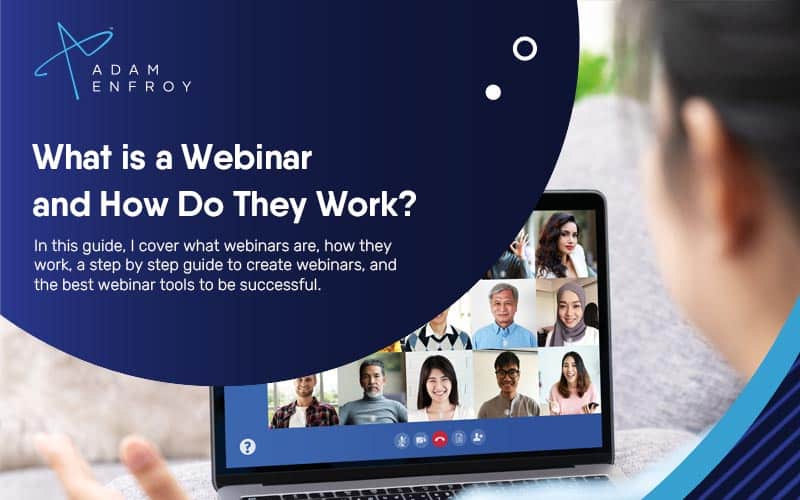
Webinars are amazing tools for educating, engaging, and captivating target audiences. A well-executed webinar can allow your business to interact with leads spread out all over the world.
No wonder then that over 60% of marketers use webinars as a content marketing tool for driving greater conversions.
At the same time, webinars work to improve brand awareness and convert leads into paying customers. All this ultimately results in increased revenue for your business and greater reach for your brand.
However, hosting a successful webinar is not as easy as it sounds. There are multiple aspects to consider when creating webinars and hurdles to overcome during distribution.
Thankfully, these hurdles aren’t anything that can’t be overcome with a bit of webinar know-how.
To help you get started with webinars, this guide covers:
- What webinars are
- How to create webinars
- The best webinar software to be successful
- Steps to create successful webinars
- Where they fall into the marketing mix
Disclosure: I receive affiliate compensation for some of the links below at no cost to you. However, these are the best tools that I have used when conducting a webinar. You can read our affiliate disclosure in our privacy policy.
What is a Webinar?

Webinar is the short form of “Web Seminar,” i.e., a meeting or conference held in a virtual environment. Webinars can be hosted as video presentations, workshops, or even training classes delivered via webinar software.
Usually, webinars are hosted and shared with the audience in real-time, also known as live webinars.
In special cases, they can be pre-recorded and then shared with the viewers at a particular date and time, or even uploaded on social media sites for distribution.
The reason webinars are so very effective is that unlike regular videos, here there’s a concept of live interaction between the hosts and the attendees. Whether the webinar is live or not, it usually has a means by which the attendees can ask questions and collaborate with the hosts.
Most webinars are usually business-related and are used to share ideas and updates with a target audience. Webinars are also great for nurturing meaningful relationships, creating and spreading brand authority, and launching new products or services.
In short, you can use a webinar to replace any regular, face-to-face interaction and place it in a virtual environment. All one needs to create a webinar is an internet connection, a computer, and webinar software tools such as GoToWebinar.
What makes webinars unique is that unlike a physical seminar where the organizers book a venue and the attendees have to visit there, a webinar is virtual. So, audiences from any corner of the world can attend these meetings and derive value.
What Makes Webinars Such Important Marketing Tools?
In the age of social media, digital interactions are replacing face to face meetings in the business world. In such a situation, webinars have emerged as a great marketing tool. Especially for B2B marketing, webinars play an essential role in the entire lead generation and conversion process.
Using webinars, your business can get to the same marketing and sales targets as with physical seminars and conferences.
Here are some of the many reasons why webinars are such useful marketing tools:
- They help create a relationship with existing as well as potential clients
- They enable clear communication with prospects, business partners, and industry peers
- Through capturing contact details of attendees, webinars help grow your lead list
- They allow you to spread the word about your brand across the world
- The webinar platform allows you to build human connections that last in the long run
As a direct result of the above, webinars are being adopted by major corporations as critical marketing tools.
Purpose of a Webinar

The primary purpose of webinars is to be used as a marketing channel. However, that’s not the only purpose for which you can use them. The following are some of the different types of webinars that you can usually spot on the internet.
1. Marketing Webinars
Marketing webinars are the most common type of webinar and are mainly used for lead generation purposes. Successful webinars also open the doors for strategic collaborations and give you access to a broader market. They also help to improve your credibility as an industry leader in your niche.
2. Educational Webinars
The next popular webinar type you can find is educational webinar presentations. Businesses are increasingly using webinars to train and upskill employees. Webinars are also excellent tools for colleges and universities to cater to an international student base.
3. Product Demo Webinars
Webinars are great for launching and demonstrating new products. Through webinars, businesses can gauge customer interest in a product before actually launching it. They also allow customers to get a first-hand experience of the product in question.
4. Onboarding Webinars
The onboarding of new employees or customers plays a significant role in maintaining business relationships. In general, it’s 5x more expensive to acquire new customers than to retain existing ones. A great webinar can go a long way towards making the onboarding and retention process easier.
Apart from the above, you can use webinars for other purposes, such as holding question and answer sessions and interviews. They can also serve as live events where you can discuss common queries and how-tos regarding your products or services. You can even address customer complaints and queries directly through a webinar.
That’s not all, however, since you need not always host webinars with a plan. They can be used as online events for sharing PowerPoint presentations, whiteboard discussions and for brainstorming in general.
Such interactivity is the essence of web conferencing and allows the alleviation of multiple pain points, a major one being the need to be physically present for a meeting. In the next section, we’ll take a brief look at how webinars achieve this.
How Do Webinars work?
Now that we know about the different types of webinars, it’s time to understand how webinars work. Like a physical seminar, a web seminar should also be held at a particular date and time. And as for the venue, it can be webcast on your website, or through social media live streams.
Before the actual event, you need to set up a landing page for the webinar and inform the target audience to register. Then, at the designated date and time, you simply webcast the event via webinar tools.
As a general rule, webinars can serve any one or a combination of the purposes outlined above. The target outcome of the webinar can be improved brand awareness, increased conversions, or a greater number of leads collected. Ideally, it should be a combination of it all.
I’ve already mentioned that a webinar is usually a live virtual event. However, webinar hosts almost always make it a point to record them. This has a twofold purpose, the first being that you can use the recording for future reference.
The second purpose is in terms of content marketing. Webinar content can be repurposed and shared as evergreen content. You can distribute the event through social media, where it can be a continued source of value for your target audience.

Common Webinar Features
The features that your webinar will have ultimately depends on the purpose you’re hosting the event for. However, there are some standard features that all webinars incorporate to engage audiences. In the following sections, I’ll take you through some of them.
1. Text-based Chat
No matter your webinar audience’s size, one of the simplest yet most effective methods of engaging them is text chats. Such chats help the audience quickly ask questions and also answer any queries you might pose to them.
Text chats act as useful tools for capturing audience attention and interacting with them. What’s more, the attendees can attract the presenter’s attention using this feature as well. Such Q/A based interaction helps to build trust and establish authority among the audience.
2. Presentations
Like in any regular meeting, webinars can also make fair use of PowerPoint presentations. Especially for educational webinars or online meetings, high-quality slides can leave a lasting impact.
Using a slide-based presentation also makes your intentions clear to the audience. You can even provide the slides as downloadable, gated content. Such marketing strategies can go a long way towards increasing your email lists’ length and providing quality leads.
3. Screen-sharing
For webinars that demonstrate a product or a process, it’s often essential to share the presenter’s point-of-view with the audience. In such a situation, screen-sharing features can be useful as they allow the audience to see exactly what you’re seeing.
Doing so has multiple advantages. For one, when you’re demonstrating how to use a product, the users can understand and follow along. Screen-sharing is definitely a more effective tool than using static screenshots.
4. Whiteboards
When you’re explaining a complex topic or idea through a live, on-demand webinar, taking notes or jotting down points can become a hassle. To overcome this problem, many webinar tools include a whiteboard feature that allows writing text and drawing images.
Such a feature gives audiences the feeling that they are right there in a classroom with you. Not only does this give them a clearer idea of the topic, but it also helps you to articulate your thoughts better


0 Comments